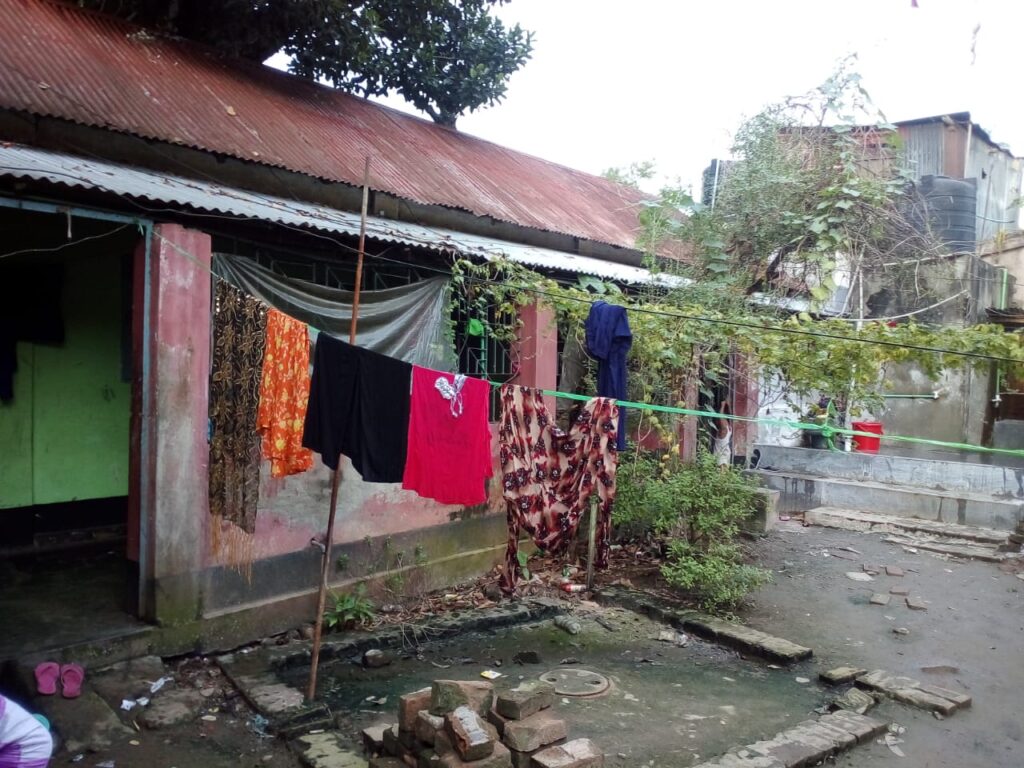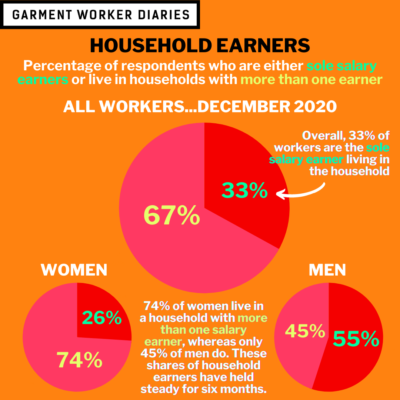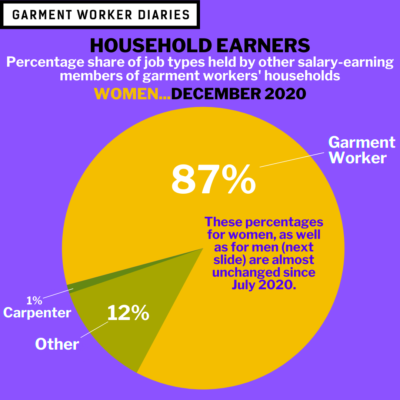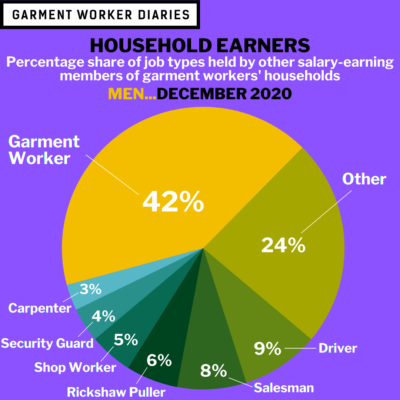During the summer last year, we introduced you to the salary-earning configuration of garment workers’ households: how many household members earn money, who are they, and what do they do? At the end of last year, MFO and SANEM asked garment workers to give us an update so we could see if household earning patterns had shifted.
In short, not much changed in the six months since the summer, with a similar proportion of additional household salary earners continuing to perform a similar proportion job types. One number that had ticked up slightly is the percentage of workers who gained consent from the other members of their household to discuss those members’ salary details with us: 83% of workers with additional household earners secured consent in July compared to 89% in December. We hope this reflects an improved sense of comfort in discussing such personal details.
Notes: Numbers in graphs may not sum to 100% due to rounding; banner photo courtesy of a garment worker in Gazipur.
Household Earner Demographics
By the end of last year, the proportion of respondents reporting to us that they were the sole household earner was very similar to the proportion from last summer:
- In December, 33% of respondents reported that they were the only household earner compared to 34% in July
- 26% of women said in December said that they were the only household earner, compared to 55% of men who said the same
That left 67% of respondents in December saying there was at least one additional household earner, compared to 66% who said the same in July.
Of the 89% of respondents in December who secured consent to discuss household finances with us, 95% confirmed that the other household earner(s) currently resided in the house (among those 5% who could not confirm, alternative living arrangements are a likely reason).
And among those who’d secured consent in December to discuss their household members’ finances:
- 91% said there was one additional earner living at home (91% in July)
- 9% said there were two additional earners living at home (9% in July)
- About half a percent said there were three additional earners living at home (also about half a percent in July)
In terms of who respondents said those other householder earners were in December and July, here’s the breakdown:
|
Household Member |
December |
July |
|
Spouse |
74% |
71% |
|
Son |
6% |
5% |
|
Brother |
5% |
6% |
|
Father |
5% |
6% |
|
Mother |
3% |
4% |
|
Sister |
3% |
6% |
|
Daughter |
2% |
2% |
|
Other |
1% |
1% |
|
Brother-in-law |
0% |
0% |
|
Cousin |
0% |
0% |
In instances where a worker reported there was an additional household earner in December, 77% of women said their spouse was an earner compared to 62% of men who said the same (compared to 73% and 57% in July, respectively).
Wages and Work Hours of Household Earners
In December, 97% of other household salary earners for whom we received data had been employed during the month. Essentially the same percentage of other household earners, 96% were employed in July. Other rates also held steady:
- The median work hours in December of 243 (240 hours for women and 250 hours for men) was almost the same as in July (239 hours overall, with women working 238 and men working 240)
- The median salary in December was Tk. 10,000 (identical for women and men), exactly the same median salary as in July (again identical for women and men)
The most common type of job for other household earners was again being a garment worker. Women were also again much for likely to work in the garment sector than men, and men were more likely than women to have one of a variety of jobs. Below is the breakdown by month, overall and by gender:
|
Type of Job |
December |
July |
||||
|
Overall |
Women |
Men |
Overall |
Women |
Men |
|
|
Garment Worker |
51% |
87% |
42% |
51% |
87% |
42% |
|
Driver |
7% |
0% |
9% |
5% |
0% |
7% |
|
Carpenter |
2% |
1% |
3% |
3% |
0% |
3% |
|
Salesman |
6% |
0% |
8% |
5% |
0% |
7% |
|
Shop Worker |
4% |
0% |
5% |
2% |
0% |
3% |
|
Rickshaw Puller |
5% |
0% |
6% |
7% |
0% |
9% |
|
Security Guard |
3% |
0% |
4% |
3% |
0% |
4% |
|
Other |
22% |
12% |
24% |
23% |
13% |
26% |
All data presented here come from interviews conducted over the phone with a pool of 1,294 workers. These workers are employed in factories spread across the five main industrial areas of Bangladesh (Chittagong, Dhaka City, Gazipur, Narayanganj, and Savar). Just over three-quarters of the working respondents are women, roughly representative of workers in the sector as a whole.



